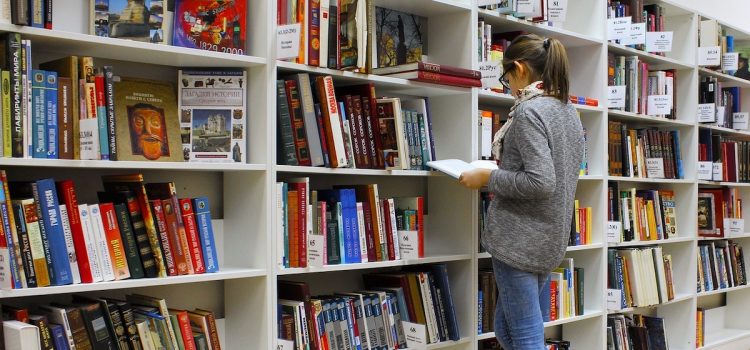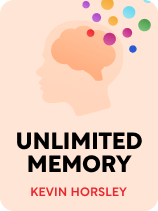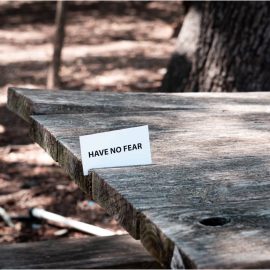

This article is an excerpt from the Shortform book guide to "Unlimited Memory" by Kevin Horsley. Shortform has the world's best summaries and analyses of books you should be reading.
Like this article? Sign up for a free trial here.
Do you often feel frustrated by your tendency to forget things? What four habits will help you improve your memory?
In Unlimited Memory, Kevin Horsley says there’s no such thing as a bad memory. You just need to train your brain so you can retain information better.
Read below for a brief overview of Unlimited Memory.
Unlimited Memory by Kevin Horsley
In Unlimited Memory, Kevin Horsley explains that, using the right techniques, anyone can train their brain to learn and remember anything. He offers several techniques to help you remember everything by making associations between things you already know well—like your car or your body—and things you want to remember. He also describes strategies to help you remember things through story, art, and visualization.
Kevin Horsley is a professional speaker and author of books such as The Happy Mind and Remembering the Presidents of the USA. He’s also a World Memory Championship medalist and has received the title of International Grandmaster of Memory—a title held by only 22 people in the world—from the International Association of Memory. This is an association devoted to connecting memory sport federations from different nations, and it governs and hosts memory competitions all over the world.
Memory: The Foundation of Learning
According to Horsley, your memory is one of your most important abilities as a human being. It underpins learning—the process of gaining new knowledge—because remembering information is the key to utilizing it. Memory is also foundational to gaining skills because all skills build on knowledge. For example, in order to gain the skill of speaking another language, you have to build the knowledge of that language’s vocabulary, grammar, and pronunciation, and then you have to remember that knowledge so you can apply it.
Improving your memory will help you in many ways: For example, you’ll be able to connect better with others by remembering meaningful details about their experiences and identities. You’ll also be able to make better decisions in the moment because you won’t have to search for the information you need to base those decisions on—you’ll just have it waiting in your memory.
Many people think of memory as a capacity you’re born with—they believe that some people simply have a better memory than others. However, Horsley asserts that this is a limiting belief: A self-fulfilling prophecy about your own limitations that keeps you from learning and tapping your mind’s full potential. In other words, if you believe you have a poor memory, this belief will hold you back and ensure that you do have a poor memory. The ability to remember information is a practice, not an innate trait, which means you can improve it through training and using memory techniques. Thus, you can incorporate a memory practice into your daily life to help you remember anything you want.
Horsley explains that you can use his techniques to achieve an unlimited memory. He uses this term literally: If you devote the necessary time and effort to it, there’s no limit to the amount of information you can remember.
Horsley explains that having an unlimited memory is a matter of adopting four habits, which we’ve condensed into three: attention, association, and practice. In the next sections we’ll explore in more detail how to adopt each of these habits.
Attention: Stay Present While Learning
Your ability to commit information to memory depends on how well you pay attention to it. Paying close attention to what you’re learning requires you to be present in the moment—focusing on the task at hand and blocking out irrelevant stimuli or interruptions. If your mind is cluttered with discouragement, distraction, or a lack of a clear goal, you can’t be present. Below we’ll explain how to manage these types of clutter to help you pay better attention.
Dealing With Discouragement
According to Horsley, the way you talk to yourself determines how well you can pay attention. If you tell yourself you’re bad at paying attention, and you believe you’re bad at it, you will be. He explains that people often have limiting beliefs that keep them from improving their abilities. These beliefs include things like “I’m unintelligent,” “I don’t have enough help from others to do this,” and “It’s too hard.” Believing these things will make them true, but shedding these beliefs will unlock your potential. To get rid of your limiting beliefs, replace them with empowering beliefs like “I have a natural aptitude for learning and remembering,” and “I can do anything I set my mind to.”
Dealing With Distraction
Another reason we struggle to pay attention and be present in the moment is that we try to do too many things at once. We often attempt to multitask when we’re learning, but Horsley explains that multitasking is impossible because you can’t direct your attention to more than one thing at a time. Research shows that multitasking slows you down and increases the number of mistakes you make. If you stop trying to multitask, you’ll find you can pay attention more closely and for longer periods than if you continue to try to split your focus. To do this, Horsley recommends training yourself to focus only on one thing at any given moment and avoid the urge to constantly distract yourself.
Creating a Clear Goal
When trying to learn something, identify two aspects of your goal: 1) what you want to learn and 2) how you want to apply it. And the more specific these goals are, the better. According to Horsley, a lack of a clear, specific goal in what you’re focusing on creates a disconnect in your mind between what you’re trying to do and what you want to do: If you don’t know what your goal is, you won’t know how to go about achieving it, and you won’t be able to tell when you have achieved it. Establishing a clear goal requires you to be curious about what you’re learning so you’ll have a better idea of how you can apply the topic to your life. This will help you establish why you’re learning this information, which makes it easier to organize your ideas and retain knowledge.
You also need to identify what about the topic interests you, because we naturally struggle to pay attention to anything that doesn’t interest us. If your topic isn’t immediately of interest to you, look for ways to connect it to things that do interest you.
Association: Connecting What You’re Learning to What You Know
Horsley’s second memory principle is association: According to Horsley, we learn everything by association. Association is when you make mental connections between knowledge you already have and the knowledge you’re trying to learn. You’re using your long-term memory (things you already know well) to latch onto items that are passing through your short-term memory. This allows you to store them in your medium-term memory (which ultimately becomes your long-term memory). This is how you make new information accessible to your brain.
For example, when you meet someone for the first time, their name is new information. When they tell you their name, it will go into your short-term memory, and unless you make a deliberate effort to create an association between that name and some other information that’s already in your long-term memory, it will fade from your short-term memory within seconds. If you meet someone named Julie, for example, you may look closely at her face and imagine her covered in jewels to help you remember the sound of her name. This will shift her name from your short-term memory to your medium-term memory, and revisiting that association will eventually push the information into your long-term memory.
The more knowledge you have, the easier it is to take in new knowledge because there’s more to connect it to. The techniques for memorization that Horsley describes are all based on associative learning. These techniques include the SEE method for remembering any information, as well as tips for organizing your memories and specific advice on how to remember lists through pegging information.
The SEE Method
To help you create such associations and make any piece of information easier to learn, Horsley recommends the SEE method. SEE stands for Senses, Exaggeration, and Energize. The SEE technique helps you make information more meaningful, and meaningful information is easier to remember than meaningless information. These three strategies can be used in any order, but Horsley recommends using all three for any piece of important information you want to remember.
Senses: Your five senses are your means of perceiving—and thus learning about—the world. Creating an association between information and your senses automatically makes it more memorable. You can use your senses to make sensory images in your mind that will make information more real and accessible to your brain. For example, say you’re trying to memorize musical terms like forte, allegro, and octave. Forte means strong and loud, and a fort is a strong structure, so create a sensory image by picturing someone standing on top of a fort (visual image) yelling loudly (auditory image) to be heard from the ground.
Exaggeration: As you’re creating your sensory associations, make them ridiculous or illogical to make them stick in your memory better. It’s easier to remember a cat the size of a thimble than a regular-sized cat, for example, or to remember a man with a neon-green mustache than a man with a mustache of a regular color. Returning to our musical terms example: Allegro means fast and lively and sounds like “leg,” so imagine a pair of legs growing comically long, like the size of skyscrapers, so they walk faster.
Energize: Once you have your exaggerated sensory images, animate them. Creating action in your images helps you turn them into a narrative, and it’s easier to remember action than nonaction. To illustrate this, consider our final musical term: octave. Octave means a range of eight notes, and an octopus has eight tentacles, so imagine an octopus animatedly playing a piano and hitting eight notes at once.
Creating Organized Memories
Another associative technique that Horsley describes is organizing your memories so they’re easier to retain. He recommends strategies in which you associate new pieces of information with things you already know well. For example, imagine you’re trying to memorize the eight primary emotions according to Robert Plutchik: joy, sadness, fear, anger, anticipation, surprise, disgust, and trust. We’ll use a home as our reference point.
Since there are eight things we’re trying to remember, we’ll identify eight places in a typical home that we can associate each word with: the computer, television, closet, dryer, oven, refrigerator, trash can, and thermostat. Now you’ll use the SEE method to create a clear image you can associate with each emotion.
- Imagine yourself happily scrolling through adorable cat pictures on social media, or gleefully purchasing a huge bouncy house online: Your computer represents joy.
- Think of the most heartbreaking movie or show you’ve ever seen and imagine yourself crying giant tears like a cartoon character: Your television represents sadness.
- Think about a huge, terrifying, growling monster hiding in your closet: Your closet represents fear.
- Imagine an angry little fairy getting tossed around and around in your dryer, getting more and more furious: Your dryer represents anger.
- Think about waiting excitedly in front of your oven for a big batch of cookies to finish baking: Your oven represents anticipation.
- Imagine yourself going to your refrigerator and finding it unexpectedly filled with flavorful, colorful dishes from many different cuisines. Your refrigerator represents surprise.
- Imagine going to your trash can and finding it overflowing with rotten food, smelling like a landfill. Your trash can represents disgust.
- Think about adjusting your thermostat, and imagine a giant thermometer with the temperature moving up and down. Consider how you don’t actually know the exact temperature of your home by any other means; you just have faith that the thermostat is correct. Your thermostat represents trust.
According to Horsley, organizing knowledge as you take it in is the best way to learn and memorize it. Every new piece of information you’re trying to memorize (the emotions) is being connected to information that’s already in your long-term memory (areas of your home).
This organizational technique involves a four-step process:
- Identify the organizational reference tool you want to use, such as your car, your body, a place you know well, or a journey or route.
- Identify places in these reference tools where you can place associations.
- Create distinctive images of each piece of information you’re learning using the SEE method.
- Assign each piece of information to one of the places you identified in step 2.
Remembering Lists and Numbers
Horsley also offers a specific associative technique to help you remember lists of items or terms. Horsley recommends the pegging method for remembering these. This involves assigning meaningful words to numbers and then associating those words with each list item. For example, if you want to remember the three states of matter—1) solid, 2) liquid, and 3) gas—you could use the following associations: “One” rhymes with “gun,” which is a solid object, so the first item on the list is “solid.” “Two” rhymes with “dew,” which is a liquid, so the second item on the list is “liquid.” “Three” rhymes with “breeze,” which refers to gases (like oxygen and carbon dioxide) in motion, so the third item on the list is “gas.”
You can make links based on the numbers’ physical shapes (like associating zero with an egg or eight with a pair of glasses) or based on words that rhyme with the numbers (like associating two with glue or nine with wine).
This technique works well for remembering numbered lists, but you can also use it to remember numbers themselves. Horsley uses a pegging system to associate numbers with consonant sounds based on how they look (vowel sounds are excluded from this and act as filler). He codes “one” as the “T” sound, for example, because the letter and the number look similar. He codes “two” as the “N” sound, “three” as the “M” sound, “four” as the “R” sound, and so on. Thus, if you needed to remember the number 124, you could remember it as the word “tuner,” “toner,” or “tinier.” Thus, by turning numbers into words and sentences, you can remember as many numbers and number sequences as you need to.
Practice: Hold on to What You’ve Learned
The attention and association techniques will help you remember things for a certain period of time, but in order to remember them forever, you need to practice and review the information regularly until it’s fully committed to your long-term memory.
According to Horsley, these reviews should take place at certain intervals to maximize your retention. First, review the information 10 minutes after you’ve learned it. For this first review, go through the information in the reverse order from which you learned it. This greatly strengthens your memory of the ideas.
Next, he recommends reviewing the information at the following intervals: one hour, one day, three days, one week, two weeks, three weeks, one month, two months, and finally three months. After that, Horsley says, the information will be permanently etched in your memory.
Make It a Daily Habit
Horsley writes that while these techniques can work for anyone, it’s not an easy process, and it won’t happen if you don’t commit to doing it. Making these techniques work requires you to devote yourself to improvement, which in turn requires discipline.
You need to decide to practice them every day. Consider what goal you want to achieve (you may have identified this in the first step when you developed your sense of direction), and commit to achieving that goal daily.

———End of Preview———
Like what you just read? Read the rest of the world's best book summary and analysis of Kevin Horsley's "Unlimited Memory" at Shortform.
Here's what you'll find in our full Unlimited Memory summary:
- Why there's no such thing as a bad memory
- How anyone can train their brain to learn and remember anything
- Memory association techniques and how to use them






